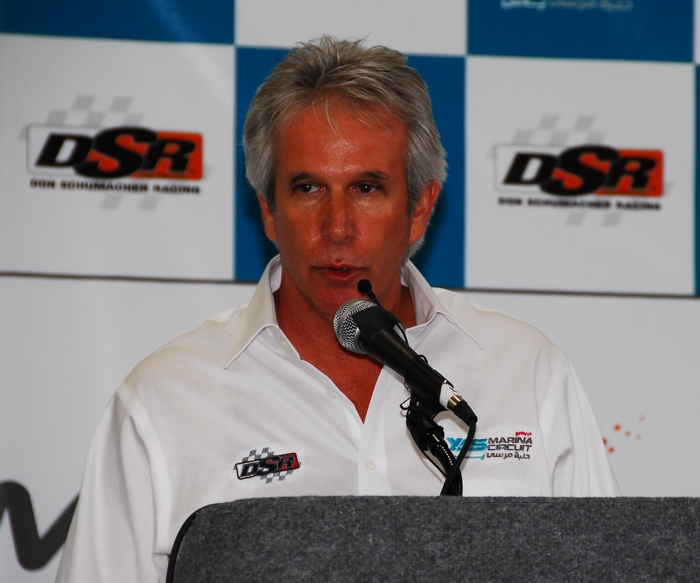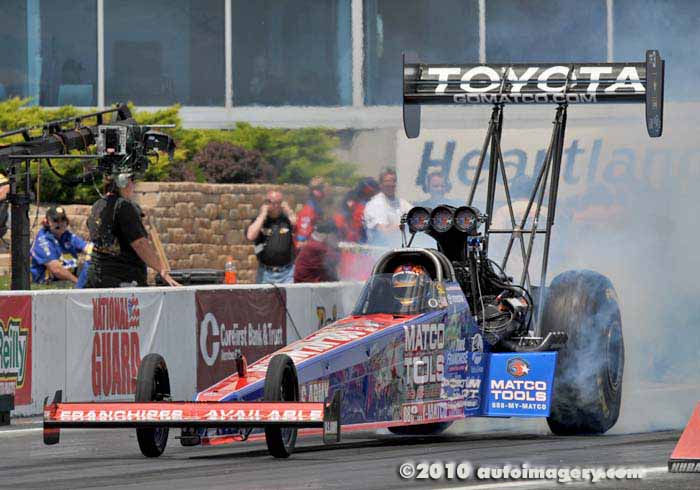LEE BEARD: KEEP THE CREW CHIEF IN THE EQUATION
 The big question in the NHRA right now is what the sanctioning body might do to reduce the power of the nitro cars with the focus on returning quarter-mile runs.
The big question in the NHRA right now is what the sanctioning body might do to reduce the power of the nitro cars with the focus on returning quarter-mile runs.Long-time crew chief and former standout driver Ed “Ace” McCulloch believes there is no reason to return to quarter-mile racing, leaving behind the 1,000-foot racing the NHRA has had in place since July of 2008.
Veteran Funny Car racer Jim Head thinks speaking to race fans directly is the key to winning support for 1,000-foot racing.
The NHRA seeks to conclude data gathering no later than July of this. Depending on what the NHRA does, there is the possibility the sanctioning body would return the nitro cars to traditional quarter-mile racing.
The big question in the NHRA right now is what the sanctioning body might do to reduce the power of the nitro cars with the focus on returning  quarter-mile runs.
quarter-mile runs.
Long-time crew chief and former standout driver Ed “Ace” McCulloch believes there is no reason to return to quarter-mile racing, leaving behind the 1,000-foot racing the NHRA has had in place since July of 2008.
Veteran Funny Car racer Jim Head thinks speaking to race fans directly is the key to winning support for 1,000-foot racing.
The NHRA seeks to conclude data gathering no later than July of this. Depending on what the NHRA does, there is the possibility the sanctioning body would return the nitro cars to traditional quarter-mile racing.
The NHRA has already tested the value of a smaller gallons per minute fuel pump, and a smaller displacement engine.
Lee Beard, who has spent more than 30 years in drag racing as a driver, crew chief and team manager, applauds the NHRA for its approach on the issue, but also believes reducing the power of nitro cars takes away the innovation element of being a crew chief.
“I give the NHRA credit that they haven’t just jumped right in here and made a knee-jerk decision about how to slow the cars down,” said Beard, a team manager at Don Schumacher Racing. “They’re compiling a lot of data from some very brilliant minds from all the different crew chiefs, and all the organizations are all coming up with different ideas. They (the NHRA) are standing back and looking at everything. I know they did some tests with some smaller fuel pumps and smaller cubic-inch motors. There are some restrictor plates being built to run on top of the super charger to maybe restrict the amount of air going in there. They haven’t made a decision and I give them (the NHRA) credit for looking at the big picture and hopefully in the end doing what is going to be right for everybody, the team owners, the crew chiefs, and certainly the spectators.”
Beard's career highlights as a crew chief and team manager include tuning Gary Ormsby to the 1989 Top Fuel world championship, guiding Cruz Pedregon to the Funny Car title in 1992 and being a part of Tony Schumacher’s Top Fuel crown a year ago.
Even with his tremendous amount of experience, Beard concedes he might not be the right guy to answers some of the questions being asked.
“I’m probably the wrong guy to ask that question (about reducing the power of nitro cars), and I will tell you why,” Beard said. “My involvement in the sport coming up through it as a young guy right out of college and going on to making a living and career out of it; the sport was all about who had the quickest and fastest car. It was a lot of innovation and it was about breaking barriers. Certain things standout in my mind, like when Joe Amato showed up with that real tall wing on the back of his dragster at Gainesville, Fla., and went 270 mph. I remember when Eddie Hill was one of the first guys to run (a time) in the fours. I remember when Kenny Bernstein ran 300 mph (in 1992) and all of a sudden it gave the media and the sport the ability to advertise 300 mph racing. I also certainly understood when we were running speeds at 335 with the Top Fuel cars and 333 with the Funny Cars, we were going awfully fast and there’s only so much real estate available at certain facilities.”
The on-track death of Scott Kalitta, a two-time NHRA world champion on June 21, 2008, changed NHRA’s stance on quarter-mile racing.
Kalitta's Funny Car, traveling about 300 mph, burst into flames and crashed at the end of the track during final qualifying for the Lucas Oil SuperNationals at Old Bridge Township Raceway Park in Englishtown, N.J. Kalitta, 46, died a short time after being taken to the Old Bridge Division of Raritan Bay Medical Center in Englishtown, N.J.
Since Kalitta’s tragic wreck, the NHRA has had both Top Fuel and Funny Cars race to 1000-feet, instead of the 1,320 foot quarter-mile.
“When the NHRA cut it back to 1,000 foot my view on it was that all of a sudden we were in a position to go ahead and start breaking barriers again, but at 1,000 feet,” Beard said. “It was like who is going to be the first guy to run in the 3.7s? Then, who is going to be the first guy to run in the 3.6s with a Top Fuel car? Then, who is going to be the first Funny Car to run in the 3s at 1,000 feet? Or, who is going to break 320 mph with a Top Fuel car? That’s what I grew up doing (making cars go fast), and that’s what I made my career at. I was fortunate enough to set the national record on numerous occasions for both elapsed times and speed. I also set a lot of different track records across the country, and that really brings a lot of satisfaction to you as a crew chief to know you’re the national record holder. You just went quicker or faster than anybody else has ever done it before. That’s my outlook personally.”
That’s why Beard isn’t favor in taking away the edge crew chiefs can gain.
“I was never really a big fan of like, IROC, where they tried to put everybody in identical cars,” Beard said. “There wasn’t that one team that was working on maybe a little more horsepower in the engine. So, I wasn’t an IROC fan. I would certainly not be a fan if the sport (drag racing) got to the point where everybody had identical equipment and it didn’t go very quick and fast. I do not know what satisfaction there would come out of it.”
Beard also thinks 1,000-foot nitro racing has been a good fit and makes sense.
“If you really studied it close, when you go 320 mph at 1,000 feet, if the driver gets the chutes out and is on the brakes, he is well under 300 at a quarter-mile,” Beard said. “So to go back (to racing) at a quarter-mile, and run 300 is actually not as safe as going 320 at 1,000 feet as far as the ability to stop the car in that given amount of real estate. So, I do not know that it would be wise to go back to quarter-mile racing with the fuel cars. I’m an opposite guy. I would like to see our team burning the midnight oil coming up with more horsepower, better aerodynamic packages, a chassis that had more grip, and be the first Funny Car to run in the 3s and be the first Funny Car to run 320 and the same way with dragsters. Can you imagine a dragster going 330 at the 1,000 foot clock, what an accomplishment that would be. That’s me, that’s Lee Beard as a racer talking.”





































